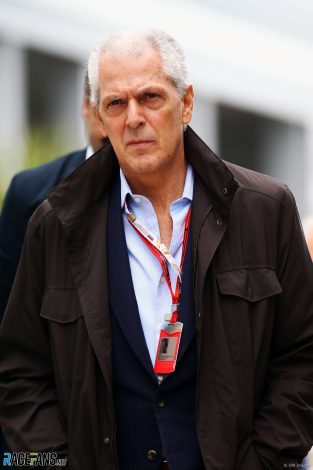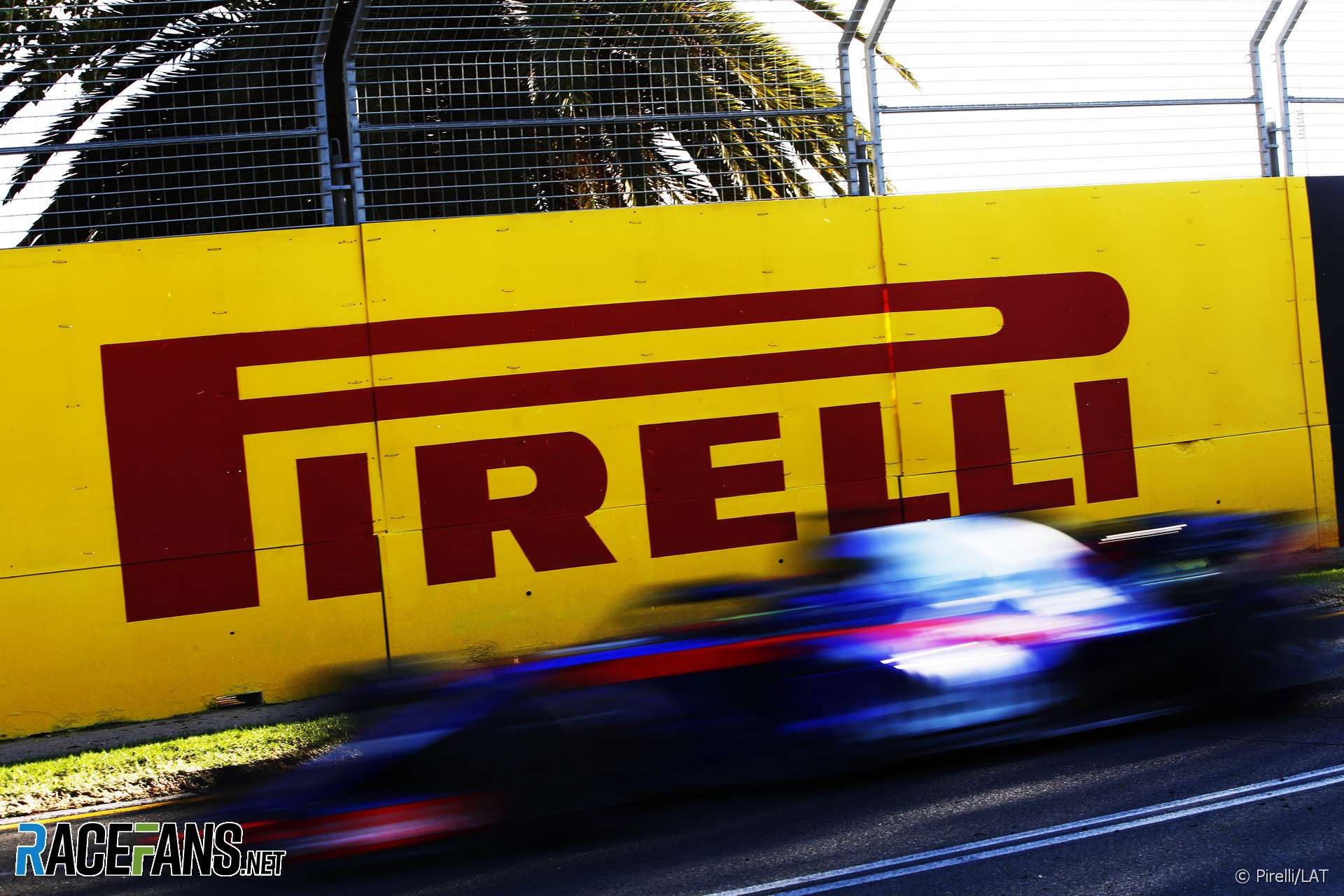Pirelli has been the official tyre supplier to Formula 1 since 2011. But how much longer will it remain in the sport?
The tyre manufacturer’s original three-year deal, and two subsequent extensions, were agreed with Bernie Ecclestone. Its current deal runs out at the end of the 2019 F1 season.
That will be Pirelli’s ninth year in F1. During its initial contract, Pirellis’ then-sporting director Paul Hembery told RaceFans it was looking for a “medium term” presence, and suggested the marketing benefit of being in F1 would decline after a decade of continuous involvement.
“Over 10 years there’s maybe less value added each year that you continue because the public perceives that you are in Formula One,” he explained. “When we were in Formula One last in the nineties it took four or five years before people realised we weren’t in it any more.”Does Pirelli management now want to stay in the sport for more than 10 years? And does F1’s new management view them as positively as Ecclestone did?
Speaking to RaceFans and other media in Monaco, Pirelli’s CEO Mario Tronchetti Provera said dealing with Liberty’s consensus-based approach compared to Ecclestone’s deal-first style was like being in “two different worlds”.
“I think Liberty are professionals,” he said. “They are willing to do the best for Formula One. They are listening a lot, trying to understand the needs of everybody and to create the best possible show. That’s the target.”
Pirelli’s entry into F1 coincided with the sport’s decision to ‘spice up the racing’ using high-degradation tyres. Questions over the quality of product Pirelli has supplied have therefore been bound up in the debate over whether having such fragile rubber makes the racing more exciting or too artificial.
Liberty Media has far-reaching plans for its first opportunity to reshape the sport in 2021. Its planned changes to engines and chassis could include a new wheel format, such as a long-mooted move to 18-inch rims.
Advert | Become a RaceFans supporter and

“We already are doing marketing a lot, we are spending a lot of money on [research and development], we continue to evolve with new products. We are serving the circus as partners, answering any request, always having in mind technology and safety these are the drivers.”
But he warned Pirelli is not prepared to stay in F1 at any price.
“Any technological challenge for us is good news,” he said. “[But] I will never enter into a ‘money challenge’, because I think that our brand is different”
“If the challenge is money, please, all the others are invited, we leave.”
Advert | Become a RaceFans supporter and
2018 F1 season
- McLaren staff told us we were “totally crazy” to take Honda engines in 2018 – Tost
- ‘It doesn’t matter if we start last’: How Red Bull’s junior team aided Honda’s leap forward
- Honda’s jet division helped F1 engineers solve power unit problem
- McLaren Racing losses rise after Honda split
- Ricciardo: Baku “s***show” was Red Bull’s fault





rob91
17th June 2018, 12:43
Let the drivers decide individually who will supply their tyres. They should not be forced to race with the same tyres as everyone else. It is supposed to be a competition.
ZUKMaN
17th June 2018, 15:56
And we will have much larger gap between top teams and midfield. High quality tyres will go top 3, others will have leftovers.
@HoHum (@hohum)
18th June 2018, 0:34
But Z the FIA could (and should) mandate that any supplier must supply any team the same tyres at a reasonable (FIA decided) fixed price.
Tristan (@skipgamer)
17th June 2018, 13:04
I might be misremembering but didn’t they get the job because they were much cheaper than Michelen, Dunlop and Bridgestone?
Dieter Rencken (@dieterrencken)
17th June 2018, 13:42
No, they were awarded the contract because they were the only tyre company prepared to commit to a single supplier contract after Bridgestone withdrew at end-2010. Michelin didn’t pitch and Dunlop has shown no interest in F1 since the 60s.
Peter Gareth
17th June 2018, 14:04
@dieterrencken were they not also the only supplier that agreed to supply tyres created to artificially degrade faster?
Erzen (@)
17th June 2018, 14:57
Iirc Michelin applied for the tender to supply tires from the 2017 season but they said that they wouldn’t be supplying unless they would make 18-inch tires that easily last the whole race. No surprise F1 didn’t award the contract to a company that was answering their call with all sorts of demands without even agreeing to a deal first.
Robbie (@robbie)
17th June 2018, 15:59
@xenif1 Your comment prompted me to investigate that, albeit just with a quick google, because I was pretty sure they never said they wanted to make tires that last a whole race if they were to come back to F1. Couldn’t find anything to that regard. I’m pretty sure they understand F1 does not want such tires.
Michelin is making no ‘demands’ but merely stating what it would take for them to consider a return to F1. The main thing is they’re no longer interested in making tires for 13” rims. They only want to make tires for 18” rims. They also have not seen F1 interested in innovation…in the innovative things they have been working on like slicks that work in the rain, and like all conditions tires. That I blame simply on the mandate carried over from the BE era that F1 currently has to wean themselves from. I think it is not a forgone conclusion that Michelin will not come back to F1, for we do not know what Liberty and Brawn have in mind for tires for 2021 and beyond.
anon
17th June 2018, 18:45
@robbie, those “slick intermediates” were not popular in the FIA WEC when they were introduced. I recall that, when they were first used at Le Mans, the Radio Le Mans team mentioned that Chevrolet sent every single one of those tyres back to Michelin and told Michelin that they thought were too dangerous to be used.
The drivers complained that, if there was enough moisture on the track, those slick intermediates were extremely vulnerable to aquaplaning and meant that the car could violently snap out of control – it was cited as a reason for some of the crashes that occurred during qualifying. The thing is, Michelin refused to give the teams any choice in the matter – Chevrolet asked Michelin to provide them with a traditional intermediate tyre for that race, but Michelin refused because it would be very damaging for their marketing if there were teams openly refusing to use those tyres.
Michelin have had a record of demanding that series change the tyre sizes to serve their advertising requirements – they wanted Formula Renault to switch to larger diameter tyres “to improve the look” of those cars, whilst in MotoGP they insisted that the teams adopted a slightly larger diameter rim to make it look more like a road bike.
Stephen Crowsen (@drycrust)
18th June 2018, 2:21
I’m sceptical of this. Actually, a more precise phrase would be “slicks that work on a wet track” because when it starts to rain on a hot day the water evaporates, and as long as the water evaporates faster than the rain falls the track will remain dryish, or at least the racing line or most used part of the road will remain dryish, allowing the slick tyres to still work.
When the track is wet, and especially with water on the surface of the road, then the ability of a tyre to adhere to it becomes dependant on the ability of that tyre to clear the water that compromises adhesion. Under these circumstances slicks are inferior to tyres with tread because slicks have less ability to clear the water on the surface of the road or track than normal road tyres with tread do, which is why most countries require road cars to have tyres with tread on them. When the tyre lifts off the road surface then there’s no adhesion, so ability to control the car is compromised.
Robbie (@robbie)
17th June 2018, 14:14
I often refer back to what Michelin said when they were last in F1. They said they wanted a competing tire maker alongside them, because that way everyone would still talk about who was winning (or losing) on what tires, and that would keep tires in the spotlight from a marketing standpoint for them. One maker making steady eddy predictable tires that aren’t the deciding factor in races, means commentators and pundits have little to talk about in terms of the same solid tires that everyone is on, and thus the marketing impact of being in F1 is diminished for the supplier.
A big reason imho Pirelli agreed to be the sole maker is because BE also wanted to make the tires gadgets to spice up the processional show, so Pirelli agreed to make sub-par tires, far inferior than they are capable of making, designed with very specific ‘needs’ in mind for a specific F1 mandate, and thus Pirelli, in spite of making said banana peels for tires, get marketing impact even as a sole supplier.
The tire file going forward is going to be a fascinating one as it relates to what Liberty and Brawn want to do. If Pirelli has seen their marketing impact starting to diminish, I wonder about Michelin coming in with 18 inch rims and even if they’re the sole maker, at least gleaning great impact from not only producing tires for the first new non-BE cars, but new look tires at that. Perhaps if the show is much improved on the track as is being touted for 2021, they won’t mind being a sole maker at least for let’s say five years or so.
Patrickl (@patrickl)
17th June 2018, 20:03
@robbie Pirelli presented that idea. Indeed they probably came up with it together with Ecclestone, but still fast dergading tyres was not something the FIA had asked for.
Michelin wanted 1 million dollars per team. That was the problem.
So Ecclestone went looking and found Pirelli who were willing toi supply the tyres for free and sign a advertising contract for all tracks. Win-win for Eccelstone. And clearly lose-lose like always when someone signs a contract with Ecclestone.
Also Michelin were pushing longer lasting tyres so they could bring less tyres to the race, but that was never an issue until Pirelli entered at the very last moment with their/Ecclestone’s fast degrading tyres idea.
YellowSubmarine
17th June 2018, 22:26
@dieterrencken Do you think there’s any appetite within F1’s teams for multiple tyre supply deals? Michelin, Pirelli, perhaps some of the upcoming Asian tyre makers like Bridgestone and Kumho would all be interested, one suspects.
anon
18th June 2018, 21:48
If the past is anything to go by, most teams would probably say no – those tyre manufacturers would probably push at least part of the costs onto the teams, and even the largest teams are not keen to reignite what has traditionally been a quite expensive area of development.
Furthermore, tyre wars tended to tilt the balance even more heavily in favour of a few rich teams that the tyre manufacturers either chose as their favourite partner, or towards the largest and richest teams that tended to dominate the testing and therefore could bias the manufacturers into designing tyres for them by ensuring the smaller teams couldn’t get a look in.
For the majority of the grid, the proposition is a losing one given that you’d probably end up with higher costs and with the possibility of the tyre manufacturer biasing their tyres towards a rival, handicapping your performance as a result.
As an aside, I wouldn’t exactly call Bridgestone – which is cited as being the largest tyre manufacturer in the world – an “upcoming” manufacturer.
Jeffrey (@jeffreyj)
17th June 2018, 13:21
BYE!!!
Robbie (@robbie)
17th June 2018, 13:44
For me I don’t really care if it is Pirelli or someone else, or even a couple of makers in F1 again, as long as they get away from these terrible tires and the ‘need’ to make them the major storyline of F1.
This has been something I have raised before, that being the big question of what the tires will be like not just for 2019, but for 2021. They can talk of the new inwashing front wings, etc etc for next year which is great, but what will the tires be mandated to be like? And especially for the massive changes coming for 2021. What will the philosophy be for those?
I am full of hope and frankly am going so far as assuming that for 2021 they will have dealt well enough with the dirty air effect that they will no longer feel the need to make bad tires the storyline in order to add some variety by attempting to use them to mask the over dependence on clean air. Over the past decades we’ve had good tires and bad, and neither has changed the processions from dirty air. So let’s deal with the dirty air (which they’re doing in a systematic way) and then they can be back on real tires that don’t limit the driver and the car.
Tire competitions (I refuse to call them a war as no other components in competition in F1, be they engines, teams, drivers, gearboxes, brakes etc are deemed a war) were never the enemy of close racing due to the result being everyone having such good tires that they practically held up all day just fine. Dirty air has always been the number one enemy to closer racing.
As the pundits spoke of during the Canadian coverage, the most exciting races on average seem to be 2-stoppers. Let’s have good tires that degrade though tread wear, not thermal wear which is way more finicky, such that two stops are necessary most of the time, and away we go, on to gladiator vs gladiator racing, rather than passenger vs passenger tire monitoring events dictated by the engineers studying tire states all day.
Phylyp (@phylyp)
17th June 2018, 18:30
@robbie +1 to your comment.
Phil Norman (@phil-f1-21)
17th June 2018, 19:32
This sounds like a common sense approach. I hope something like this is adopted.
@HoHum (@hohum)
18th June 2018, 0:50
@robbie, mostly agree and applaud, however the 2-stop excitement only happens because the drivers don’t have to worry (much) about the crappy tyres not lasting for 1/3rd of a race, if the tyres lasted the whole race, like MotoGP, we could see exciting racing without pit-stops and tactics would revolve around the tyre choice and the in race performance trade-off.
Jimmi Cynic (@jimmi-cynic)
18th June 2018, 19:59
“we could see and boring processional racing without pit-stops..”
@hohum: fixed that one little typo and 2005 wants you back in the paddock.
F1 racing will never be like MotoGP unless the rules force teams to lop off two wheels and a thousand kilos of aero.
Klon (@)
17th June 2018, 13:46
To be honest, I have no idea why Pirelli are still dealing with this nonsense. They get blamed for having tyres that last too long, they get blamed for tyres that don’t last long enough. Quite frankly, dealing with current F1 is a PR department’s worst nightmare.
Robbie (@robbie)
17th June 2018, 14:47
Can’t really agree. They’re in F1 eyes wide open, mandated to make poor tires to theoretically spice up the show, and ‘all’ we seem to talk about is tires, especially during the races, so Pirelli is complicit in getting their marketing impact this way. This is what happens when the mandate is to intentionally mess with tires to make them gadgets to do a specific thing. They could make good tires all day long but then we wouldn’t talk about them much.
ColdFly (@)
17th June 2018, 14:47
There are only a few people who blame Pirelli. Most fans understand that they are asked to make a degrading tyre, and all occasional viewers admire them for being the tyre chosen for the fastest cars. @klon
As long as they are in the news they’ll reap the benefits.
GT Racer (@gt-racer)
17th June 2018, 17:25
@coldfly The reason Pirelli get ‘blamed’ isn’t so much because of the degrading tyres because most understand thats what they were asked (Not told) to do……. Where they do deserve blame is the way they have opted to achieve that.
A lot of the problems with the tyres in F1 since 2011 hasn’t been simply down to them been designed to degrade, They have been purely down to Pirelli’s approach to doing it.
If you look at Firestone in Indycar for instance, They have actually been building increased wear into there tyres for the past 2-3 years but you never hear about operating windows or any of the other negatives or other problems you regularly hear in F1 because Firestone have gone about things properly.
What Pirelli did was find the cheapest/easiest solution (Thermal degredation) & then started putting additional chemical compounds into the tyres to ensure that at certain temperatures the tyre compounds began to break down & shred, Eventually when the top compound layer of the tyre is gone whats underneath causes the tyres to cool suddenly & this is what became known as ‘the cliff’.
Firestone have created a tyre that wears more naturally by simply using softer compounds and/or thinner threads & from a fans perspective you don’t really notice anything apart from lap times dropping when they start to wear & you certainly don’t hear tyres talked about or been complained about as often as you do in F1.
Patrickl (@patrickl)
17th June 2018, 19:57
@coldfly No one was asked to make fast degrading tyres. That was never part of the brief that was made for the new tyre deal. Only Pirelli touted that idea.
Michelin was the main contender for the new tyre deal and they were pushing longer lasting tyres so less tyres would be needed (to reduce cost)
Only when, at the very last moment, Pirelli was dragged in by Ecclestone did Pirelli introduce the idea of fast degrading tyres. To mimic what happened in a Canada race.
Erzen (@)
17th June 2018, 14:53
+1 on this
Pirelli has been consistently doing what F1 has asked of them. Everyone remembers the tyre blow-outs at Silverstone 2013 but seems to forget how fast Pirelli reacted to fix the issues with their product, which as a matter of fact were a result of misuse by the teams and entirely not Pirelli’s fault. They’ve dealt with a lot in F1 and i’m happy to have them stay, but i would understand if they feel that it wouldn’t be good for them
GT Racer (@gt-racer)
17th June 2018, 17:44
@xenif1
The problem with that argument is that running tyres under pressure, Running ‘extreme’ levels of camber & under certain circumstances running tyres on the wrong side of the cars were completely normal in F1 & had been for decades & actually continues to be in other categories.
In the past suppliers like Good year, Bridgestone & Michelin created tyres that were fine with been pushed to & beyond the recommended limits understanding that this was a part of F1 & that teams were always going to be pushing boundaries in search of performance.
The problem with the Pirelli’s is that they never designed the same sort of margins into the tyres that allowed them to be pushed to/beyond the limits. There fine when run as recommended, But as soon as you try to push them there far more prone to suffering problems. Additionally in 2013 they had introduced that steel belt that was also causing the tyres to run hotter than usual which made them more prone to certain kinds of failure.
The tyres really should have been able to cope with what the teams were doing because it was normal practice, Pirelli were perfectly aware of it but instead of altering it’s tyres to ensure they suited the needs of F1 they expected F1 to change to suit there tyres which the FIA eventually did with the post silverstone 2013 regulation changes making F1 the 1st & only racing series that i’m aware of to actually create rules catering to it’s tyre supplier rather than the tyre supplier creating a product that caters to the needs of the series it’s competing in.
anon
17th June 2018, 18:55
@gt-racer, I still find it rather odd that, for example, if it was supposed to have been so normal and frequent for teams to run the tyres on opposite sides of the car, there seems to have been no mention of it at all in the past, either in written articles or in audio commentary, for something that you would have expected an external observer to note.
GT Racer (@gt-racer)
18th June 2018, 1:19
The running of tyres of the wrong side of the car wasn’t something that was done every weekend or anything, That was something that was done on occasions where it was found to be beneficial.
But the reason you never heard much about that or teams running tyre pressures as low as 13psi or some of the more extreme camber levels is because it was seen as normal practice & that sort of stuff in general wasn’t a big talking point & not something anyone outside of the teams really put any attention on.
@HoHum (@hohum)
18th June 2018, 0:54
@klon, they will be advertising their multiple F1 championships long after it’s been forgotten that they were the sole supplier, which is why they should get out now.
Tifoso1989 (@tifoso1989)
17th June 2018, 17:44
@xenif1
Playing with cambers, tyre pressure, inverting tyres… All those tricks have been practised in F1 since the 70s. The tyre blow-outs at Silverstone 2013 were caused by low quality tyres which the construction was made from steel that is cheaper than Kevlar.
F1 Engineer
18th June 2018, 8:20
You are exactly right. Pirelli have been producing garbage for F1 and are incapable of providing a tire that allow the cars and drivers to maximize their performance over an entire tire stint or even over 1 lap.
Agg
17th June 2018, 18:38
If they do fine, if not there are plenty of tire manufacturers that could easily take their place.
Patrickl (@patrickl)
17th June 2018, 19:52
Please stop perpetuating this bit of false propaganda. It was Pirelli who proudly came up with this idea!
Probably they came up with this together with Ecclestone, but still. It wasn’t the sport/FIA who requested this change. Not at all.
Michelin was close to a deal and there was none of this fast degrading tyre nonsense. In fact they wanted longer lasting tyres and then less of them to reduce cost.
The problem was that Michelin wanted to be paid. Which obviously was an issue for Ecclestone who doesn’t like to pay he wants everybody to pay him. So at the eleventh hour he dragged in Pirelli with their fast degrading tyres idea and Ecclestone got his huge sponsoring deal with Pirelli advertising at all the tracks.
Andrew in Atlanta
18th June 2018, 3:02
Where do you keep getting this idea Michelin held back because of money? Michelin was NEVER coming to F1 without it being an open tender, period that was it. There was no more money needed, no 18″ rims or we leave. It was open your comp, they didn’t want to be the single supplier. They requested F1 consider 18″ rims but it was NOT part of the initial proposal when the tender was opened.